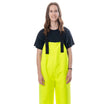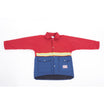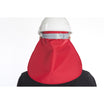The construction industry, a world replete with ingenuity and structural masterpieces, offers an exciting realm of possibilities. However, it's also a hazardous field, with risks lurking around every corner. To mitigate these threats and significantly maintain the welfare of construction workers, safety gear has emerged as an indispensable accessory. In recent years, advancements in technology have transformed traditional safety equipment into innovative lifesaving gadgets. This article delves into these technological advancements and how they've revolutionized safety gear in the construction industry. From wearable tech to augmented reality, we'll explore the cutting-edge safety tool designs keeping construction sites safer than ever before.
Importance of Safety Gear in Construction
Ensuring the safety of construction workers has always been a concern for any construction management team. But how do we make construction sites safer? The answer lies in the persistent and proper use of safety gear. The importance of safety gear in construction goes beyond mere compliance with regulations; it serves as a life-preserving shield against potential hazards and injuries at the workplace.
Protection Against Hazards
Construction sites abound with hazards that can cause physical harm to workers. These include everything from falling debris to harsh weather conditions, and even potentially damaging noise levels. This is where safety gear steps in as the first line of defense for construction workers.
- Helmets and Hard Hats: These protect the head from falling debris, while also insulating against electric shocks.
- Goggles and Safety Glasses: These protect the eyes from dust, debris, and bright lights that could cause sight damage.
- Safety Vests and Harnesses: These items make workers more visible to machine operators and can prevent catastrophes like being hit by moving equipment. Additionally, harnesses protect against falls from heights.
And then, of course, there is the safety gear designed specifically for more adverse conditions. An excellent example of this is specifically engineered rain gear that effectively protects workers from the impact of harsh weather conditions, thereby Transforming Safety with Gear.
Reduction in Workplace Injuries
Adopting the use of safety gear results in a significant reduction in workplace injuries. Here's how:
- Proactive Protection: Safety gear offers active protection, warding off injuries before they can occur. For instance, wearing high-visibility clothing can prevent vehicle-related accidents.
- Less Downtime: With fewer injuries, there is less need for medical leave or time off for recovery. This means workers can stay productive and projects can stay on track.
- Improved Morale: When workers know they're safer, they're generally happier. Happy workers are known to be more productive and efficient, which is a bonus for any project.
With such compelling reasons, it's clear why safety gear plays a crucial role in the construction industry. It's not just about regulatory adherence—it's about caring for the people who literally build our world. Let's all champion for better, well-equipped workplaces where safety is inherent and uncompromised.
Innovations in Construction Safety Gear
There's no denying the fact that innovations in technology are shaping the future of several industries. One area that’s experiencing significant changes is the construction industry, specifically in the realm of safety gear. Safety has always been a pertinent issue in construction, but thanks to these advancements, hazards are now being mitigated in ways like never before. This article will delve into some of the exciting trends reshaping the construction safety landscape from wearable tech to "smart" personal protective equipment (PPE).
Wearable Tech
Wearable technology is not only limited to smartwatches or fitness trackers for personal use. These have penetrated the construction industry in a big way to augment safety. Workers now wear gadgets like moisture-wicking shirts with built-in heart rate monitors, safety vests with GPS trackers, and even smart work boots equipped with motion sensors. These tools offer two-fold benefits - they keep a regular check on the health status of the workers and send immediate alerts in case of danger.
Augmented Reality (AR)
Augmented Reality (AR) has taken a leap from the gaming world to be a practical tool for construction safety. It creates an enhanced version of reality by overlaying virtual information on the real world. AR can assist workers by providing real-time data, showing potential hazards, and offering pre-construction visualizations - thereby ensuring a safer working environment.
Biometric Sensors
Biometric sensors have been an absolute game changer in the quest for advanced construction safety. These can monitor vital signs like heart rate, blood pressure, and body temperature, making it easier to keep tabs on the workers' health status. If any medical irregularities are detected, instant alert signals are sent out, potentially saving lives in emergency conditions.
Robotics
Contrary to popular belief, robots in the construction field are not about replacing workers but enhancing their safety. From drones surveying hazardous areas to autonomous machinery that can perform risky tasks, the introduction of robotics is significantly reducing on-site dangers.
Smart PPE (Personal Protective Equipment)
Personal Protective Equipment (PPE) has evolved from merely being protective gear. Intelligent systems in helmets, goggles, or even rain gear are revolutionizing safety in construction sites. This smart gear offers comprehensive benefits - it not only protects the workers from physical harm but also provides insights and early warning signals to prevent accidents.
Embracing innovation in the form of advanced safety gear is leading to safer construction sites and, subsequently, a safer industry as a whole. It's a fascinating era with different types of smart equipment playing their part to keep construction workers safe while on the job. Technology is indeed revolutionizing safety, and it's evident that improved gear, including the likes of intelligent rain gear, is adeptly enhancing safety standards in the realm of construction. The future of construction safety is undoubtedly promising, attributed to the relentless advances and adoption of these innovative tools.
Advancements in Material Science for Construction Gear
Imagine an industry that continually evolves and innovates. An industry where the safety of its workers is paramount, and every ounce of effort goes into ensuring they are shielded from potential hazards on the job. That industry is construction, and the heroes are the scientists and engineers working tirelessly to advance construction gear materials. This transformative journey from conventional materials to advanced, futuristic materials has been nothing short of a miracle.
Impact-resistant Materials
Whether it's steel structures toppling over or tools accidentally dropped in high-rise edifices, construction sites are fraught with potential dangers. The advent of impact-resistant materials has significantly mitigated the risk of serious injuries.
These materials, often embedded with polymers known for their absorption and dispersal properties, significantly mitigate the impact of collisions and falling debris. Hard hats and other protective gear now come equipped with these materials allowing workers to perform their duties with an added layer of safety and peace of mind.
Heat- and Fire-resistant Materials
The risk of fire and intense heat is not new to the construction industry. I-beams can get exceptionally hot, welding sparks may fly off errantly, and combustible materials can cause fires. Enter the world of heat- and fire-resistant materials.
These materials, characterized by their ability to resist high-temperature exposure, have become integral components of construction gear. Fire-resistant gloves, heat-resistant boots, and other protective garments have become commonplace, offering resistance to intense heat or sporadic fire incidents at the site.
Improved Harness and Safety Line Materials
Improved fall protection is paramount to the safety of construction workers who work at great heights. Enter state-of-the-art harnesses and safety lines.
These strings of life are usually made from ultra-high-molecular-weight polyethylene (UHMWPE), known for its robust tensile strength. This material is renowned not only for its durability but also for its flexibility. A perfect blend of strength and flexibility means these harnesses provide maximum safety and comfort for the wearer.
Moreover, remember the time when tear-resistant gear was a thing of the future? Yes, that future is here with the Rise of Tear-Resistant Gear. This advancement has reinforced harnesses and safety line materials, further improving safety measures.
In the grand scope of construction safety, advancements in material science for construction gear have instilled a sense of security among workers. The drive for continual innovation and improvement in this arena is a testament to the construction industry's commitment to worker safety, reinforcing the belief that every life is precious and every hazard preventable.
Regulating Industries and Standards for Safety Gear
Investing in safety gear is a key component for businesses around the world who wish to protect their workforce and maintain smooth operations. Good safety gear can prevent many workplace injuries and fatalities. However, ensuring the quality and efficacy of this gear can be challenging, hence the necessity for regulation. This is where organizations such as Occupational Safety and Health Administration (OSHA) and The International Safety Equipment Association (ISEA) come in, paving the way for standardized regulations and guidelines for safety gear.
OSHA Regulations
OSHA plays a monumental role in the world of safety gear. Established by Congress in 1970, OSHA's mission is to "assure safe and healthful working conditions" for men and women alike by setting and enforcing standards. One of the organization's crucial areas of impact is the regulation of personal protective equipment (PPE).
OSHA has devised specific regulations for PPE used across various industries:
- General Requirements: Regulation (Standard - 29 CFR) 1910.132 outlines that employers must provide and maintain necessary PPE for their employees in certain work situations.
- Eye and Face Protection: Regulation (Standard - 29 CFR) 1910.133 states specific requirements for PPE for eye and face protection when workers are exposed to hazards such as flying particles, molten metal, liquid chemicals, and harmful light radiation.
- Respiratory Protection: Regulation (Standard - 29 CFR) 1910.134 provides comprehensive guidelines for respiratory protection wherein employers must establish and maintain an effective respiratory protection program.
- Head Protection: Regulation (Standard - 29 CFR) 1910.135 stipulates that employers must provide head protection to employees who could potentially suffer from impact, electrical shocks, or burns to their heads.
International Safety Equipment Association (ISEA)
On a more global scale, the ISEA takes charge of standards for safety gear. Founded in 1933, this association sets the benchmark for personal protective equipment and technologies that ensure safe workplaces. ISEA's work is complementary to OSHA, working directly with manufacturers and testing labs to develop and approve performance standards for safety products.
ISEA's list of accomplishments is impactful and expansive:
- High-Visibility Safety Apparel Standard: Developed in 1999, this standard, now known as ANSI/ISEA 107, provides guidelines for the design, performance specifications, and use of high-visibility safety apparel.
- Industrial Head Protection Standard: ISEA established the ANSI/ISEA Z89.1, a performance and testing standard for industrial helmets.
- Hand Protection Classification: ISEA developed the ANSI/ISEA 105 standard, which addresses the classification and testing of hand protection for specific performance properties related to mechanical, thermal, and chemical hazards.
Working together, OSHA and ISEA create an environment of safety, health, and well-being for workers all over the globe. Their regulations and standards ensure that safety gear isn't merely an afterthought, but a truism established within the pillars of every industry's foundation. It is essential for businesses to be aware of these regulations and work towards implementing them for the safety and security of their workforce, thus creating a safe, healthy, and more efficient work environment.
Future Trends in the Safety Gear Industry
As we look towards the horizon, the safety gear industry promises a landscape filled with exciting developments - a fusion of technology, sustainability, and predictive analysis. As advancements continue to redefine how we understand and approach workplace safety, knowing the upcoming trends is paramount. These trends are poised to not only revolutionize safety measures but also amplify productivity and efficiency in various industries.
Integrating AI and Machine Learning
Artificial Intelligence (AI) and Machine Learning are set to revolutionize the safety gear industry. This revolution spans beyond the ordinary, as AI can now be incorporated into safety gears to offer enhanced levels of protection and ergonomic designs that marry comfort with safety. These algorithms can identify patterns, allowing the development of safety gear that proactively responds to hazardous scenarios and adjusts its protective functions accordingly.
For instance, AI-integrated helmets can assess factors like temperature or air quality, making them intelligent enough to warn users of impending risk. This hand-in-hand fusion of AI and safety gear propels a new world of possibilities, transforming traditional safety approach into a smart, predictive, personalized experience.
Predictive Analytics for Safety Assesment
Predictive analytics is another game-changer in the safety gear industry, acting as a preventive measure to protect workers. Companies are leveraging this technology to meticulously analyze multiple data points regarding workplace safety, creating prediction models that help assess potential risks before they occur. Through this technique, safety gear can experience timely upgrades and modifications, precisely tailored to tackle projected safety concerns.
Eco-friendly and Sustainable Gear
The call for sustainability echoes across industries. In response, the safety gear industry is gearing towards creating eco-friendly products. Future safety gears are expected to be produced with materials that are not harmful to the environment, illustrating a trend towards sustainable & environmentally-conscious production - which, in turn, paves the way for a greener future.
This trend is also visible in sectors like construction, where attention to safety and ecological impact is critical. For instance, the advancements set to come into play by 2023 involves Elevating Construction Safety through the strategic use of well-designed, eco-friendly gear. This shows that safety is intertwined with environmental care, which calls for an even more insightful exploration of sustainable options.
In the not-so-distant future, the safety gear industry will be marked by smarter, predictive, and eco-friendly trends. Catering to these trends effectively will essentially shape the trajectory of the industry and also redefine the paradigms of safety, efficiency, and sustainability in various workplaces around the world.
Conclusion
The construction industry is in the midst of a revolution, ushering in unprecedented advancements in safety gear technologies. From innovations such as wearable tech, augmented reality, biometrics, robotics, to smart personal protective equipment, the focus is undeniably on enhancing safety and reducing workplace injuries. The industry is also witnessing major breakthroughs in material science leading to the development of thoroughly impact-resistant, heat-, and fire-resistant materials.
Regulatory bodies like OSHA and the ISEA also play a significant role in ensuring the best standards for safety gear. Then again, keep in mind that the dawn of a new era is upon us, with the integration of technologies like AI, machine learning, and predictive analytics in the world of safety gear.
The future indeed looks promising with not just technological advancements but also a shift towards environmental consciousness with the rise in demand for eco-friendly and sustainable gear.
The journey towards a safer work environment begins with you making the right choice for your safety gear. If you consider a future-proof, reliable, and robust safety gear, look no further than Rain Gear Pro's premium chainsaw safety pants. They are designed with attention to detail, providing unparalleled protection and optimal comfort. Melding innovation, expertise, and high-quality materials, these pants signify the future of construction safety gear. You can check these out and more on our website. It's not just a gear, it's an essential lifeline between you and the hazards of the workplace.
Frequently Asked Questions
-
What are some innovative construction gear that improve safety?
Some innovative construction gear that improve safety include: 1. Smart helmets with built-in sensors for detecting falls or impact, 2. Exoskeletons to reduce strain and prevent injuries, 3. GPS-enabled tracking devices for real-time location monitoring, 4. High-visibility smart vests with integrated LED lights, and 5. Smart gloves with sensors for detecting hazardous substances.
-
How do smart helmets enhance safety in construction?
Smart helmets enhance safety in construction by integrating sensors that can detect falls or impact, alerting nearby workers or supervisors in real-time. They also often come with built-in communication features for easier coordination and emergency response.
-
What are the benefits of using exoskeletons in construction?
Using exoskeletons in construction helps reduce strain on workers' bodies and prevents injuries related to lifting heavy objects or repetitive tasks. Exoskeletons provide support to the wearer's muscles and joints, improving overall safety and reducing the risk of musculoskeletal disorders.
-
How do GPS-enabled tracking devices improve construction site safety?
GPS-enabled tracking devices improve construction site safety by allowing real-time location monitoring of workers. In case of emergencies or accidents, supervisors can quickly locate and provide assistance to workers. These devices also help ensure compliance with safety protocols and prevent unauthorized access to restricted areas.
-
What are the advantages of using high-visibility smart vests with LED lights?
High-visibility smart vests with LED lights significantly enhance visibility and safety, especially in low-light or high-traffic construction environments. The LED lights increase worker visibility to others, including vehicle operators, reducing the risk of accidents and improving overall safety on site.





















Leave a comment
This site is protected by hCaptcha and the hCaptcha Privacy Policy and Terms of Service apply.